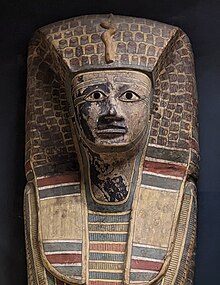| Sekhemre-Heruhirmaat Intef | |||||||||||||||||||||||||||||||||||||||||||||||||
|---|---|---|---|---|---|---|---|---|---|---|---|---|---|---|---|---|---|---|---|---|---|---|---|---|---|---|---|---|---|---|---|---|---|---|---|---|---|---|---|---|---|---|---|---|---|---|---|---|---|
| Intef VII | |||||||||||||||||||||||||||||||||||||||||||||||||
 Rishi coffin of Sekhemre-Heruhirmaat Intef, on display at the Louvre Rishi coffin of Sekhemre-Heruhirmaat Intef, on display at the Louvre | |||||||||||||||||||||||||||||||||||||||||||||||||
| Pharaoh | |||||||||||||||||||||||||||||||||||||||||||||||||
| Reign | 16th century BC late 17th Dynasty | ||||||||||||||||||||||||||||||||||||||||||||||||
| Predecessor | Nubkheperre Intef | ||||||||||||||||||||||||||||||||||||||||||||||||
| Successor | Senakhtenre Ahmose | ||||||||||||||||||||||||||||||||||||||||||||||||
Royal titulary
| |||||||||||||||||||||||||||||||||||||||||||||||||
| Father | Possibly Nubkheperre Intef | ||||||||||||||||||||||||||||||||||||||||||||||||
| Burial | Tomb at Dra' Abu el-Naga'? | ||||||||||||||||||||||||||||||||||||||||||||||||
| Dynasty | 17th Dynasty | ||||||||||||||||||||||||||||||||||||||||||||||||
Sekhemre-Heruhirmaat Intef (or Antef, Inyotef, sometimes referred to as Intef VII) was an ancient Egyptian king of the Seventeenth Dynasty of Egypt, who ruled during the Second Intermediate Period, when Egypt was divided between the Theban-based 17th Dynasty in Upper Egypt and the Hyksos 15th Dynasty who controlled Lower and part of Middle Egypt.

Sekhemre-Heruhirmaat Intef is referred to as Intef VII in some literature, while others refer to him as Intef VIII.
Sekhemre-Heruhirmaat Intef ruled from Thebes, and was buried in a tomb in the 17th Dynasty royal necropolis at Dra' Abu el-Naga'.
Brief reign
Wooden Sarcophagus, Louvre E 3020
His only clear attestation is his coffin – Louvre E 3020 – now in France. His sarcophagus contained the corrected nomen of this king as well as his prenomen, Sekhemre-Heruhirmaat, "which was added in ink on the chest of the coffin."
Coptos, block
Little more is known concerning the reign of this king except that he was a short-lived successor of Nubkheperre Intef. The Danish Egyptologist Kim Ryholt has argued that Sekhemre-Heruhirmaat Intef was possibly a co-regent of Nubkheperre Intef based on a block from Koptos, which preserves
... the nomen and prenomen of Antef N together with the unfortunately almost lost prenomen of another king. The prenomina of both kings are given the epithet di-ˁnḫ and since this was normally used only for the ruling king, it may be inferred that these kings co-reigned."
Ryholt observes that the length of the damaged cartouche would fit well with the long prenomen of Sekhemre-Heruhirmaat.
Ryholt suggested that Sekhemre-Heruhirmaat Intef died prematurely and was buried in a royal coffin that initially belonged to Nubkheperre Intef; hence, Sekhemre-Heruhirmaat Intef did not enjoy an independent reign of his own. The British Egyptologist Aidan Dodson, however, criticises Ryholt's proposal that Sekhemre-Heruhirmaat Intef died during the reign of his predecessor and was buried in Sekhemre-Wepmaat Intef's original royal coffin. Dodson observes that the form of the name Intef written here (which was originally similar to that used to designate Nubkheperre Intef before it was amended for Sekhemre-Heruhirmaat Intef) and the added king's prenomen of Sekhemre-Heruhirmaat on this king's coffin was composed in an entirely different hand from the remaining texts on the coffin. Dodson also stresses that
On the matter of the coffins of the Inyotef kings, Ryholt fails to address the key point that the container used for Sekhemre-heruhirmaet (his "Inyotef H") is certainly a "stock" coffin, made lacking the deceased's name, to be inserted later—just as was that later used for the burial of Kamose. On this basis, there seems no possibility of the former having been the original coffin of Inyotef N, pressed into service for his prematurely defunct co-regent. The reviewer's previous explanation of the changed spelling of the nomen thus remains the most likely, and may also provide an explanation for the inclusion of the prenomen: in view of the confusion in the mind of the scribe, he made sure that the king was correctly identified in the Hereafter by adding his prenomen as well!
Dodson's previous explanation derives from his GM 120 (1991) article where the author argues that Sekhemre-Heruhirmaat Intef was most probably a short-lived Theban king who died within months of his accession to power since the temple "scribes were probably still used to writing Inyotef in the manner of Nubkheperre , leading to the corrected mistake on the coffin ".
This would also explain the modesty of Sekhemre-Heruhirmaat Intef's coffin, which lacked a royal uraeus and is stylistically similar to the clearly non-royal coffin of Kamose. Intef, hence, would not have had the time to create a proper royal coffin in his abbreviated reign.
The prominent German Egyptologist Daniel Polz who rediscovered the tomb of the powerful 17th Dynasty king Nubkheperre Intef at Dra' Abu el-Naga' in 2001 also places Sekhemre-Heruhirmaat Intef as a short-lived successor of this influential pharaoh in a 2007 book just prior to the accession of Senakhtenre Ahmose.
References
- ^ Jürgen von Beckerath, Handbuch der ägyptischen Königsnamen (= Münchner ägyptologische Studien, vol 46), Mainz am Rhein: Verlag Philipp von Zabern, 1999. ISBN 3-8053-2310-7, pp. 128–29
- Chris Bennett, "A Genealogical Chronology of the Seventeenth Dynasty", Journal of the American Research Center in Egypt, Vol. 39 (2002), pp. 123–155 JSTOR
- Dodson, Aidan and Hilton, Dyan. The Complete Royal Families of Ancient Egypt. Thames & Hudson. 2004.
- Kim S. B. Ryholt, The Political Situation in Egypt during the Second Intermediate Period, c. 1800–1550 BC, CNI Publications, Vol: 20, Copenhagen: Museum Tusculanum Press, 1997, pp. 177, 204, 266, 289, 395
- Kim Ryholt, The Political Situation in Egypt during the Second Intermediate Period, Museum Tusculanum Press, (1997), p. 267
- Ryholt, p. 267
- Given life
- Ryholt, p. 268
- Aidan Dodson, Book Review of Ryholt, K. S. B., The Political Situation in Egypt..., Bibliotheca Orientalis LVII No. 1/2, January–April 2000, p. 51
- Dodson, Bi Or, LVII No. 1/2, pp. 51–52
- Aidan Dodson, "On the Internal Chronology of the Seventeenth Dynasty", Göttinger Miszellen 120 (1991), p. 36
- Daniel Polz, Der Beginn des Neuen Reiches. Zur Vorgeschichte einer Zeitenwende. Sonderschriften des Deutschen Archäologischen Instituts, Abteilung Kairo, 31. Berlin/New York: Walter de Gruyter, 2007. p. 50
| Preceded byNubkheperre Intef | Pharaoh of Egypt Seventeenth Dynasty |
Succeeded bySenakhtenre Ahmose |